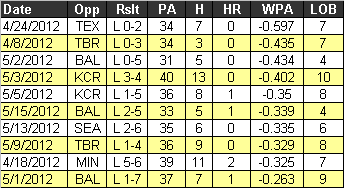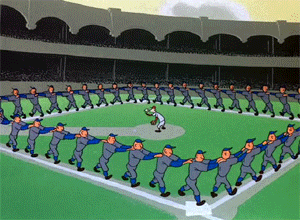One and Done
Nice piece by Rick Paulas over at the Awl on ball players who had a cup of coffee in the big leagues.
[Photo Credit: Shhilja]
Color by Numbers: Loaded Questions
What would the Yankees’ record be if their performance with runners in scoring position was on par with recent seasons? With a few key hits at the right moment, the Yankees could be resting comfortably in first place, but so far this season, the team hasn’t been able to land the big blow with the same amount frequency. And, in no situation has that been more evident…and costly…than when the Yankees have loaded the bases.
Yankees Offensive sOPS+ Rates, 1996-2012

Note: sOPS+ compares a team’s split to the adjusted average for the major leagues. A reading above 100 is considered above average for an offense.
Source: baseball-reference.com
Entering play on Wednesday, the Yankees ranked near the bottom of the major leagues in terms of batting average, on-base percentage, and slugging (.151/.222/.302) with the bases full. Based on OPS, not only does that performance rate fail to attain even 50% of the major league average, but it also ranks as the franchise’s third lowest output since 1948. Also, the differential between the team’s overall offensive production and its performance with the bases loaded is currently larger than at any point over the same timeframe.
Clearly, the Yankees have been laggards with the bases loaded, but is this really a bad harbinger? Based on correlation from 1996 to now, the Yankees’ performance with the bases loaded has only been moderately related to overall run production as a percentage of the league average (r=.62). Meanwhile, the link between relative runs scored and OPS with men in scoring position has been more significant (r=.78). So, if anything, fans who are inclined to worry should focus their concerns on the more broad number.
Yankees’ Bases Loaded vs. Overall OPS, 1948-2012

Source: baseball-reference.com
It hasn’t been all bad news for the Yankees with the bases loaded. While the hitters have struggled in such situations, the pitching staff has done a good job wiggling out of trouble when the bags are jammed. In 42 plate appearances with the bases loaded, opposing hitters have produced at rates of .263/.262/.368 (sOPS+ of 76), including 13 strikeouts and only one walk. It might only be a small consolation, but at least Yankees’ pitchers have been able to offset some of the offense’s missed opportunities by imposing the same frustration on the opposition. Unfortunately, since 1996, there has been no correlation between the Yankees’ ability to limit the damage in bases loaded situations and prevent runs overall (r=.04), so there doesn’t seem to be much benefit from that guilty pleasure.
Yankees Pitching sOPS+ Rates, 1996-2012

Note: sOPS+ compares a team’s split to the adjusted average for the major leagues. A reading below 100 is considered above average for a pitching staff.
Source: baseball-reference.com
An optimist probably looks at the Yankees’ ability to hang around first place despite its offensive struggles with runners in scoring position as a positive sign. Meanwhile, the pessimist might consider the offense’s inefficiency to be a systemic problem that will prevent the team from outscoring the deficiencies of the starting rotation. Which side are you on? I take a little from both. The lineup’s track record suggests the Yankees’ offense will soon start making up ground on the past, but it won’t matter if they can’t stay ahead of the current opposition. A few more hits with the bases loaded would definitely be nice, but the real loaded question is whether the pitching staff can ensure that those runs will be meaningful when they finally cross the plate.
You Only Die Twice
Here’s a nice chat between Jeff Pearlman and Shawn Green:
JEFF PEARLMAN: So I’ve always wanted to ask a ballplayer this, especially one I covered. When I was on the beat, I loathed the ritualistic nonsense of the clubhouse. What I mean is—I enter the room, I need to talk to Shawn Green. I see you at your locker. I wait to come over, you’re talking to Carlos Delgado, I pause, then I approach, you pick up a magazine, I pause. You know I’m there, I presume, but keep reading. I finally come over, ask a banal ice-breaker. Are you, as a player, as aware of this as I am?
SHAWN GREEN: The truth is, in general athletes don’t like the media. There are always certain guys you like, and there are always certain guys you can’t stand. The other writers all sort of get lumped into the middle. And, obviously, as an athlete the bigger you are in the game, the more attention you get. For me … well, it depended. In Los Angeles a lot of the players didn’t like T.J. Simers, because he could be very critical. I actually liked him, because I felt like I understood what he was doing. He would poke you, hope you’d blow up, then he’d poke you the rest of your life. I just never blew up, and I spoke to him without any incident or problem. What I didn’t like were the reporters who would just show up every once in a while, act like they were your best friend, then crush you in print. I understand reporters have to do their jobs, but that’s what bothered me—when it was unfair.
As for the clubhouse, there are definitely times as a player, it’s an unwritten thing, but you mess with reporters and make them wait a little while. I was much more likely to lean that way if I had a great game than a bad game. When I had a bad game I just wanted to take my medicine and move on.
Comings and Goings
One of our favorite blogs, Pitchers and Poets, is calling quits. We don’t expect that this’ll be the last we hear from Eric and Ted, though (and there’s always their bitchin’ tumblr site to follow).
Meanwhile, another old friend, Jay Jaffe, makes his debut at SI.com today. Head on over and bookmark his new address.
And in Yankeeland, Brett Gardner is inching toward a return. Won’t be this week though. Can’t be soon enough.
[Photo Credit: Justin Edmonds/Getty Images, via It’s a Long Season]
The Man Who Wasn’t There
Here is a good piece on Chris Bosh by Chris Haberstroh over at ESPN.
[Photo via Fast Company–Chris Graythen/Getty Images]
Color By Numbers: Hare Today, Playoffs Tomorrow
The Yankees head into a much needed off day on a two-game winning streak, but the team still finds itself in fourth place with a disappointing 23-21 record. A four game deficit in the loss column is hardly insurmountable, especially in May and particularly when the division leader has been a perennial loser for the last 14 years, but there are still some signs of caution evident in the Yankees’ relatively slow start.
Most Yankees’ fans probably have little doubt that the Bronx Bombers will soon overtake the first place Baltimore Orioles, but history suggests that the O’s chances of sustaining their fast start are actually pretty good. Regardless, the bigger question for the Yankees is will they be able to flip the switch and play at a much higher level for the remainder of the season. According to the franchise’s historical record, the road to the playoffs has been paved with a fast start, so this year’s team certainly has its work cut out.
Considering the 2011 Yankees started out 24-20 and still went onto win 97 games, this year’s slow start by franchise standards (70% of Yankees’ teams began with a better record over the first 44 games) hasn’t really caused a panic. However, it’s worth noting that last year was more of an exception than the norm. Not surprisingly, the Yankees’ final regular season record has been highly correlated to performance in the first quarter (r=.73 since 1901; r=.68 since 1961, when the 162 game season was initiated), so, if history holds, this year’s Bronx Bombers could be facing an uphill battle.
Yankees’ Historical Winning % (Full Season and After 44 Games) Correlation

Source: baseball-reference.com
Another somewhat ominous indication is the fact that only two Yankees’ teams who started the season as slowly as the current edition bounced back to win the division. What’s more, only six of the 46 first place finishes in franchise history started out with a winning percentage below .550. More often than not, when the Yankees’ have had a successful season, the team has gotten out of the gate quickly. This relationship is even stronger when only considering championships as nearly 60% of the franchise’s 40 A.L. pennants and 27 World Series victories came in seasons when the team’s winning percentage was at least .600 after 44 games.
Distribution of Yankees’ Postseason Teams Based on Record After 44 Games

Source: baseball-reference.com
Every season has its own set of mitigating factors that influence the final outcome. However, aggregate data can often smooth out some of the variables, providing a rough road map for what the future holds. As last year (which is probably the most relevant comparison, considering the proximity) proved, the Yankees are more than capable of shaking off early season doldrums, but that doesn’t mean fans, or the team itself, should minimize some of the struggles. If the Yankees do recover once again, they will need to perform much better across the board, and their ability to do so should not be taken for granted. In some arenas, slow and steady may work just fine, but in the pennant race, a fast start has always worked to the Yankees’ advantage.
Do You Believe in Miracles?
There is a long profile on Ivan Nova by Jorge Arangure Jr. over at ESPN. Check it out.
[Photo Credit: AP]
Morning Art
In Living Color. Nifty redesign by John Turney over at Uni Watch.
Father Knows Best
Chris Jones profiles Bruce Jenner in the latest issue of Esquire:
Bruce Jenner has taken it upon himself to rescue his ridiculous extended clan by doing what none of its other members will ever do: He has elected to lose. The person in the house who has most earned his fame has chosen to accept the least of it. “I’m done with competition,” he says. He says that in response to a question about his helicopters, whether he might fly them in the professional events that have been cropping up around the country, but he means it about everything. Jenner has made decisions, now, here, during his own second life. He has made up his mind once again. His singlet is in storage because he wants it to be. He’s the one who locked his medal away in the safe.
“Going through what I went through,” he says, “being that obsessed, is not what I would consider a good, well-rounded life. You’re selfish with your time. You’re selfish with your thoughts. You don’t have to grow up. All you’re concerned with is scoring points.”
Jenner has learned that perfection comes in many forms. He has learned that a private mastery is just as satisfying as a public one. He has learned that a curse isn’t a curse if it’s a choice. And he has learned that there may be no greater love a father can give his children than to accept that his life really didn’t begin until theirs did.
Yanks Win by a Nose, but Offense Doesn’t Pass the Smell Test
It wasn’t the resounding breakout game most Yankees’ fans have been desperately anticipating, but on the strength of three runs, and Alex Rodriguez’ game ending throw, the Bronx Bombers finally managed to squeak out a much needed victory.
May has mostly been a gloomy month for the Yankees, but one bright spot has been the baby steps taken by Phil Hughes. In tonight’s game, the right hander broke out of the gate strong, but then fell victim to two old bugaboos. In the top of the third, Hughes left an 0-2 pitch over the plate to Humberto Quintero, who promptly lined an RBI double into the right field corner. Entering the game, Hughes had allowed opposing hitters to bat an astounding .293/.341/.537 (or 191% better than the league average) when ahead in the count 0-2, so Quintero’s run scoring hit was only the latest in a season’s worth of frustration born of poor location.
The Royals added to their lead in the fourth inning when Jeff Francoeur drove a 2-0 fastball into the left field seats. The long ball has been a season-long tormenter of the Yankees’ starting rotation, but no one has been more vulnerable than Hughes, who has been victimized at least once in each of his starts. In 47 1/3 innings, Hughes has now allowed 11 home runs, giving him the third highest rate per nine innings among all qualified major league starters.
The negatives aside, Hughes did manage to hold the Royals to only two runs over six innings, which was important because the offense wasn’t quite ready to bust out. The Yankees finally got on the board when Robinson Cano launched a long home run in the fourth inning, but the winning rally was much more subdued. In the bottom of the fifth, the Yankees loaded the bases on a seeing-eye grounder, hit by pitch, and bunt single, setting the stage for another golden scoring opportunity. With the memory of last night’s failure with bases loaded still fresh in everyone’s mind, Derek Jeter fell behind in the count, but finally produced a run with a single that was flared into right. Would this be the hit that would jump start the Yankees’ struggling offense and put an end to their futility with runners in scoring position? Unfortunately, the answer was no. After Curtis Granderson’s ground out produced another run, Alex Rodriguez and Raul Ibanez each went down swinging to end the rally.
Although the Yankees may not have exited the inning with good feelings, they did come away with the lead. Keeping it, however, wouldn’t be easy. Over the final three innings, Joe Girardi used five different relievers to record the last nine outs (such is life without Mariano), but his master plan almost hit a snag in the bottom of the ninth inning. With two outs, Alex Gordon, who had doubled, was at third when Alcides Escobar hit a grounder that Rodriguez fielded deep behind the bag. Arod’s only play was to desperately put his entire body into the throw, which hurtled across the diamond as Escobar raced down the line. The ball finally nestled into Mark Teixeira’s outstretched glove just ahead of the base runner, giving the Yankees a victory by the narrowest of margins, and, perhaps, a one-day reprieve from having to answer questions about not getting the big hit.
Art and Design
Dig the beauty that is all things Eephus. Bethany Heck’s got it going on. Thank you, Lady, for making our day brighter.
Painting by Kevin Vanhooser.
Here Today…
A few weeks ago Glenn Stout said that we won’t really feel Rivera’s absence for awhile. The void, that’s what will make it sting he said. And yesterday, as the game reached the seventh inning it hit me (again): Rivera is gone. Just when you get used to someone, poof. Maybe they are like Chipper Jones or Alex Rodriguez, a slow but sure decline, still playing but no longer great. Or like Mo, a quick injury and then…who knows?
Such was the case for our old pal Lance Berkman who sustained an ACL injury the other night. His career might be over. I always enjoyed watching him play. He’s had a fine career.
Color By Numbers: To Homer, Or Not To Homer? Should That Be the Question?
Around this time last year, I took a look at the growing belief that the Yankees hit “too many home runs” and concluded there wasn’t much wisdom in that unconventional thought. However, following a recent period of offensive malaise, the same theme has popped up once again. So, let’s take another look.
Yankees’ Record in Homerless Games, Since 1918

Source: Baseball-reference.com
A fashionable statistic making the rounds this morning is the Yankees 0-8 record when the offense fails to hit a home run. Despite the very small sample, this still seems to be a very intriguing relationship, especially when you consider that in half of those games the Yankees only allowed four or fewer runs. What’s more, the team’s bottom-four and six of the bottom-10 games in terms of WPA (win probability added) also happen to come from among the eight they’ve played without hitting a home run. So, it seems as if the team’s offense has suffered from a feast or famine syndrome with the long ball. However, that doesn’t mean the problem is “too many home runs”.
Yankees’ 10 Lowest WPA Games, 2012

Source: Baseball-reference.com
So far this season, 91 of the Yankees’ 177 runs, or just over half, have come via the home run, which compares to 44% cumulatively between 1996 and 2011. Of course, it should also be noted that the Yankees’ current run/game average of 4.76 is almost three-quarters off the .5.48 rate posted from 1996 to 2011. In other words, the Yankees aren’t hitting too many home runs. They just aren’t scoring enough runs, which is mostly a byproduct of a recent dry spell with runners in scoring position (it wasn’t too long ago that the team was scoring at a historic pace).
Just as the Yankees have found it difficult to win when they don’t hit a home run, the team has had good success when its pitchers keep the ball in the ballpark. Unfortunately, there have only been seven such occasions, which is by far the lowest percentage of homerless games since at least 1918. With the exception of C.C. Sabathia, Yankees’ starters have given up more than their fair share of homers, which, in turn, has significantly mitigated the relative power advantage that the team usually enjoys. This is the real problem.
Percentage of Games in Which Yankees Have Not Allowed a Home Run, Since 1918

Source: Baseball-reference.com
It’s easy to understand why so many Yankees’ fans harp upon the team’s offense. Historically, the Bronx Bombers have been a team defined by the strength of its bats, so when the lineup underperforms those high expectations, it becomes easy to point the finger at the offense. Having said that, just because the offense hasn’t been a weakness doesn’t mean there isn’t reason for concern. Although the Yankees’ offense is still very strong when compared to the rest of the league, it might not be good enough to overcome the team’s underperforming rotation. That’s why the Yankees biggest concern shouldn’t be the number of home runs hit by its lineup, but instead the amount allowed by its starters.
I Wuz Framed
Dig this piece at by Jeff Sullivan at SB Nation on the infuriating Jose Molina.
[Photo Credit: Rob Carr/Getty Images; David Goldman/AP]
Back to the Dock
Dock Ellis is back in amination.
Fear and Faith in Phoenix
Charlie Pierce lowers the boom:
One thing is certain. Paige Sultzbach and her teammates deserved a chance to play for the championship. They were the only undefeated team in their league, and they’d already beaten Our Lady of Sorrows twice this season. They’d worked hard enough, and played well enough, to be allowed to win their championship on the field, and not have it handed to them because somebody hiding in a chapel somewhere decided not to give them the satisfaction. For all the theological dust they’ve thrown up to cover their cowardly retreat, Our Lady of Sorrows plainly and simply didn’t want to lose to a girl.
This is an embarrassment to sport and to religion, the functional equivalent of bleeding statues and the face of Jesus on the side of the barn. This is the kind of thing of which Blessed John XXIII was trying to rid the Catholic Church when he called on the council to “throw open the windows” and release the stifling air of repression that had built up over the centuries. Our Lady of Sorrows doesn’t want to play baseball against Paige Sultzbach because it’s run by an organization that harbors an attitude toward women that differs very little from that of Bishop Williamson, its crackpot avatar. And, no, I don’t have to “respect” the stand they took, or the beliefs that prompted it, unless I’m also prepared to “respect” the anti-Semitism and conspiracy-mongering that are at the heart of the beliefs in question. I’m not required to be as classy as Paige Sultzbach, state champion.
[Photo Credit: Carlos Chavez/Arizona Republic]
Million Dollar Movie
They are shooting “42” at the legendary Rickwood Field.
Our pal Jeb Stewart sends these pictures.
I dig the inflatable crowd.
Blinded With Science (Poetry in Motion)
Over at Verb Plow, Glenn Stout has a thoughtful take on the Art vs. Science approach to appreciating baseball:
There is a war in baseball that rarely comes up on the field of play yet rages in the stands, the press box, in print and online 365 days a year.
On one side of this battle are those that consider baseball a science and believe that numbers tell us more about the game than any other approach. On the other side are those that consider the game an art and hold that baseball is an activity far too complicated and discreet to be contained in a series of calculations.
Neither side speaks much to the other, and when they do those discussions usually degenerate into a series of playground taunts between straw men, Science eschewing the Art crowd as ignorant louts and esthetes blind to logic, and Art denigrating the practitioners of Science as socially stunted denizens of their parent’s basements.
I delicately wandered into this battle a few weeks ago when, in responding to a Facebook discussion Charlie Pierce was involved in on the merits of Mike Cameron versus Dwight Evans I quipped that “Baseball is an art not a science.” Moments later the esteemed Joe Posnanski and a few others gently reprimanded me, one wagging his finger and writing “They don’t keep score at the ballet, Glenn.” Of course I realized the question was not as simple as either comment decreed, so rather than throw dirt bombs back and forth over the back fence I decided to step back, analyze the structure of the disagreement and try to determine if that tells us anything about the veracity of either approach.
[Photo Credit: Fecal Face]
--Earl Weaver




















![2008_1222_0001_dock_ellis_77_1080[1]](http://www.bronxbanterblog.com/wordpress/wp-content/uploads/2012/05/2008_1222_0001_dock_ellis_77_10801.jpg)




